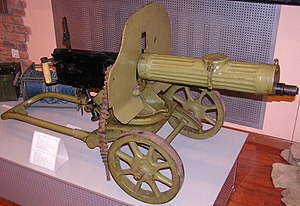PM 1910
| PM 1910 | |
|---|---|

|
|
| general information | |
| Country of operation: | Russia, Soviet Union, China, North Korea, Vietnam |
| Developer / Manufacturer: | Hiram Maxim , Tulski Oruscheiny Sawod |
| Manufacturer country: | Russia, Soviet Union |
| Production time: | 1912 to 1945 |
| Weapon Category: | Machine gun |
| Furnishing | |
| Overall length: | 1067 mm |
| Weight: (unloaded) | 23.8 kg |
| Barrel length : | 721 mm |
| Technical specifications | |
| Caliber : | 7.62 × 54 mm rows |
| Possible magazine fillings : | 250 cartridges |
| Ammunition supply : | Ammunition belts made of textile |
| Cadence : | 500-600 rounds / min |
| Number of trains : | 4th |
| Twist : | right |
| Closure : | Knee joint closure |
| Charging principle: | Recoil loader |
| Lists on the subject | |
The PM 1910 ( Russian Пулемёт Максима образца 1910 года , Pulemjot Maxima obrasza 1910 goda ) was a Russian machine gun.
history
As the name suggests, the weapon was based on the Maxim machine gun . The first MGs in service with the tsarist army were license models of the Maxim from British and German production. After signing a license agreement, production began in Russia itself around 1904. The first models still used a bronze cooling jacket and weighed over 25 kg. The heavily revised and simplified model from 1910, on the other hand, was made entirely of steel. In addition, it had a recoil amplifier on the muzzle, which aided the charging process. The pipe socket for the supply of fresh cooling water was replaced by a large radiator cap after 1942. This enabled snow to be stuffed into the running jacket in an emergency.
The need for weapons of this type could never be met in Russia. This was already the case in the First World War. All attempts to develop a modern heavy machine gun instead of the robust PM 1910 failed, so the Red Army was still dependent on it during World War II. In total, more than 600,000 units were built until a replacement was available in 1943 with the Gorjunow SG-43 .
In Finland the weapon was built as the Maxim M / 09-21 , a modification with a higher cadence was the Maxim M / 32-33 .
commitment
While the armed forces of other countries usually provided their Maxim with a tripod, in Russia the Sokolow wheel mount named after its designer was often used. This massive carriage had steel wheels and a removable protective shield, which alone weighed 8 kg. When fully equipped, the MG weighed more than 66 kg. In addition, the mount could also be used as a tripod. On the other hand, the machine guns were also attached to horse-drawn carts , so-called Tatschankas . As an anti-aircraft weapon, four MGs were bundled in a tubular frame that was mounted on the flatbeds of trucks. The air-cooled aircraft machine gun PW-1 was developed on the basis of the PM 1910 . The weapon was used not only by the Russian and Soviet armed forces, but also as a prey weapon by other armed forces.
After the Second World War, the Soviet Union decommissioned its holdings and passed them on to allied states. In this way, specimens reached North Korea and China and were used in the Korean War. Some of these machine guns eventually appeared on the side of the North Vietnamese army in the Vietnam War .




